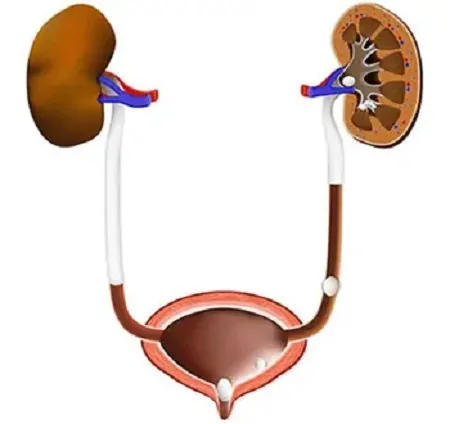Vesicoureteric Reflux Treatment in India by Dr. Prashant Jain
Vesicoureteric reflux is the condition in which the urine flows back from the bladder to the ureter. This condition is also known as vesicoureteral reflux.

Vesicoureteric reflux is the condition in which the urine flows back from the bladder to the ureter. This condition is also known as vesicoureteral reflux. There is a progressive flow of urine from the kidney to the bladder through ureters. The uni-directional flow of urine from kidney to urinary bladder is ensured by the flaps situated between the ureter and urinary bladder (vesico-ureteric junction). This condition is commonly diagnosed in infants and young children.
In this condition, the urine may flow back form one or both the ureters. Based on the severity of symptoms and extent of disease, the urologist generally grades this condition from Grade 1 to Grade 5 with Grade 1 mildest form and Grade 5, a severe form. Fortunately, most children recover from this condition as they get older. The vesicoureteric reflux is divided into primary and secondary.
What Are The Causes Of Vesicoureteric Reflux?
The causes of vesicoureteric reflux are different for primary vesicoureteric reflux and secondary vesicoureteric reflux.
Primary vesicoureteric reflux: In this type of vesicoureteric reflux, the valve between the ureter and urinary bladder does not work properly. This results in backflow of urine. This is the most common cause of this condition in children. However, as the age increases, the ureter and bladder become mature, and the valve regains functioning. If the urine flows back from only one ureter, it is termed as vesicoureteric unilateral reflux, and if both the ureters are involved in the backflow of urine, the condition is termed as vesicoureteric bilateral reflux.
Secondary vesicoureteric reflux: There are various causes of secondary vesicoureteric reflux. In some cases, there is a blockage of urine due to abnormal tissue fold in the urethra (posterior urethral valve) and in conditions like neurogenic bladder. Obstruction in bladder outlet prevents the voiding of complete urine from the bladder. In cases of neurogenic bladder, the child may also have damaged nerves that control contraction and relaxation of the bladder resulting in reflux.
What Are The Symptoms Of Vesicoureteric Reflux?
Symptoms of vesicoureteric reflux depend upon the severity and complications of the disease. The patients with vesicoureteric reflux may experience the following symptoms:
· Recurrent urinary tract infection
· The excessive urge to urinate
· Fever
· Cloudy urine
· Frequent urination
· Pain during urination
· Bedwetting
· Urinary retention
· Loss of appetite
· Irritability
· Presence of protein in the urine
· High blood pressure
How Vesicoureteric Reflux Is Diagnosed?
The vesicoureteric reflux can be diagnosed both before and after birth. Before birth, the condition can be diagnosed through the ultrasound, which reveals swelling in kidneys (hydronephrosis). Various techniques that are used to diagnose the condition are:
Laboratory workup: Many children have the recurrent urinary infection as the primary symptom of this condition. Thus, urinalysis is done to determine the presence of urinary tract infection.
Imaging techniques: Kidney, bladder, and ureter ultrasound is done to determine the presence of any structural abnormalities.
Micturating cystourethrogram (MCUG):It is a specialized X-ray of the urinary tract. During this procedure, the doctor places a small catheter in the bladder and fill the bladder with a special dye. The X-ray is taken before and after urination. The doctor, by evaluating the flow of dye, determines if the urine flows back in the ureter.
Nuclear scan: During this procedure, the doctor uses a radioisotope. The detector detects the isotope and determines any damages in kidney.
How Vesicoureteric Reflux Is Treated?
The following are the management options available for vesicoureteric reflux:
Medications: Low dose of antibiotics is provided to the children to prevent urinary tract infection. However, regular monitoring is required to determine the presence of urinary tract infection. Further, doctors should implement imagining techniques to monitor the progression of the disease. Besides various precautions are to be taken like avoiding constipation, perineal hygine and frequent voiding to reduce the risk of infection.
Surgery: Various types of surgeries are available for treating vesicoureteric reflux. Open surgery is done to repair the larger problem in the urinary tract and involves anesthesia. Robotic-and laparoscopic surgery is done to repair the valve between the ureter and urinary bladder. Endoscopic surgery is performed to strengthen the valve with the use of a bulking agent. Ureteric reimplantation is surgery in which the doctor disconnects the ureter and urinary bladder and reattaches them at an angle to create a valve.
What Are The Preventive Measures For Vesicoureteric Reflux?
Although there are no measures to prevent the vesicoureteric reflux, certain measures may improve the health of the urinary tract. These are:
· Regular urination and cleaning from front to back.
· Drinking enough fluids.
· Eat plenty of fiber-rich food to avoid constipation.
· Change the diaper frequently or as soon as it gets dirty.
· Get proper treatment for urinary and fecal incontinence.
What Is The Prognosis Of Vesicoureteric Reflux?
Most children with this condition recover on their own. Surgery has a high rate of success, with a 97%-99% positive outcome. Early diagnosis and monitoring of the condition reduces complications.
What's Your Reaction?














